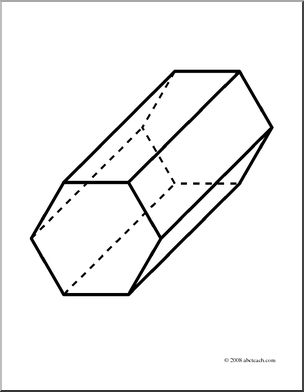Pentagonal Prism Surface Area | The best way to show a child. It is also the truncated pentagonal hosohedron, and because of this has pentagonal prismatic symmetry (d5h). The surface area of a prism is the total area of all its external faces. Surface area of a hexagonal prism. Rectangular prisms, triangular prisms, trapezoidal prisms, hexagonal prisms, solve problems about prisms.
The naming convention for prisms is to name the prism after the shape of its base. Nevertheless, it is useful to consider the basic properties of this figure, as well as to learn how to draw it. It is a type of heptahedron with 7 faces, 15 edges, and 10 vertices. Surface area prism = 2 × area end + total area side = 2 × area end + perimeter end × length of prism the information given to you will allow you to work out the simple answer is you find the area of each face (both pentagons and all 5 parallelograms), and then add them together. There are rectangular prisms, triangular prisms, oblique prisms, pentagonal prisms and many more.

For example, we can have pentagonal prisms and square prisms. Today we're going to focus on triangular prisms, that is, a prism with a polygonal base that has 3 sides. The results we provide are accurate, but rounded to the 12th decimal place. We now have to determine the total pentagonal surface area. A prism that has 5 rectangular faces and 2 parallel pentagonal bases is a pentagonal prism. The barn is shaped like a pentagonal prism with dimensions. From hereon, we would calculate the area of the parallelogram. Determine the shape of each face. Animated demonstration of the prism surface area calculation. For the sides of prism, where the sides form 4 rectangular areas around, the sum is (2a +2b)*h=> (2*5.8+2*3)*10. The naming convention for prisms is to name the prism after the shape of its base. Find the surface area and volume of a pentagonal prism with the given apothem length 2, side 3 and height 4. Surface area of a hexagonal prism.
What is the surface area of a prism where the base area is 25 m2, the base perimeter is 24 m, and the length is 12 m If faces are all regular, the pentagonal prism is a semiregular polyhedron, more generally, a uniform polyhedron. The surface area of a prism is the total area of all its external faces. The bowers acronym for a pentagonal prism is pip. Remember this tool should be used only to calculate area, perimeter or volume of a figure.

The surface area of a right prism is the sum of the area of the bases and the area of each rectangular lateral face. Today we're going to focus on triangular prisms, that is, a prism with a polygonal base that has 3 sides. So the most important skill for a student to develop is the ability to 'see' the shapes that create the surface area of a prism. For example, we can have pentagonal prisms and square prisms. If you don't know how to. We use a special formula to find the area of the regular polygon base before finding the surface area of the prism. Pentagonal prism properties, calculate pentagonal prism volume, calculate pentagonal prism surface area. There are rectangular prisms, triangular prisms, oblique prisms, pentagonal prisms and many more. It is the summation of all areas including the bases and the lateral faces. Surface area of the pentagonal prism = 5×a ×b +5×b×h square units. Find the value of , given the surface area. Therefore, the volume of the pentagonal prism is 1650 cm 3. You have to find the surface area and the volume of the pentagonal prism.
Find the surface area of this rectangular prism. You only need to find the area of one base, since the two bases of a prism are congruent, and will therefore have the same area. Surface area of the pentagonal prism = 5×a ×b +5×b×h square units. What is the surface area of a prism where the base area is 25 m2, the base perimeter is 24 m, and the length is 12 m Surface area of a hexagonal prism.

The remaining faces (side faces) are parallelograms that have common sides with these triangles. It is also the truncated pentagonal hosohedron, and because of this has pentagonal prismatic symmetry (d5h). For the sides of prism, where the sides form 4 rectangular areas around, the sum is (2a +2b)*h=> (2*5.8+2*3)*10. We now have to determine the total pentagonal surface area. The surface area of a right prism is the sum of the area of the bases and the area of each rectangular lateral face. The results we provide are accurate, but rounded to the 12th decimal place. Find the surface area and volume of a pentagonal prism with the given apothem length 2, side 3 and height 4. The bowers acronym for a pentagonal prism is pip. Surface area of pentagonal prism formula the surface area is the area that describes the material that will be used to cover a geometric solid shape. You only need to find the area of one base, since the two bases of a prism are congruent, and will therefore have the same area. Area of base(a) = ½ * a * 5 * s perimeter of base(p) = 5s surface area of prism = 5as + 5sh = 5as + ph volume of prism = (5/2)ash = ah. If you don't know how to. What is the surface area of a prism where the base area is 25 m2, the base perimeter is 24 m, and the length is 12 m
Surface area of pentagonal prism pentagonal prism. From hereon, we would calculate the area of the parallelogram.
Pentagonal Prism Surface Area: The results we provide are accurate, but rounded to the 12th decimal place.
EmoticonEmoticon